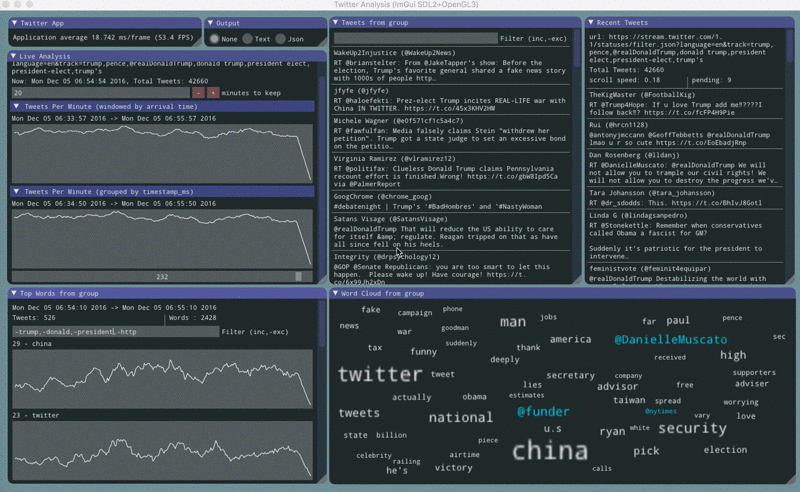Flux Architecture in rxcpp
Flux Architecture
Flux Architecture is a pattern popularized by Facebook. The Flux pattern organizes the flow of an application into a pipe of action -> dispatcher -> model -> view. While it is primarily applied to client applications today, the same pattern applies to server applications as well. Incoming requests to a server are actions and outgoing responses are the view.
Several people have recognized that the dispatcher is a two line Rx expression.
scan(make_shared<Model>(), [=](shared_ptr<Model>& m, Reducer& f){
return f(m);
}) |
start_with(make_shared<Model>())
scan()is likereduceandaccumulateexcept that the state is emitted every time it is modified.
A
Reducerisfunction<Model(Model&)>. Every change to theModelis applied by emitting aReducerinto thescan()
counting tweets
Store the count in the Model.
struct Model
{
// ...
int total = 0;
// ...
};
Collect the actions that produce reducers.
vector<observable<Reducer>> reducers;
Split the incoming tweets into 1 second windows on a background thread.
reducers.push_back(
ts |
onlytweets() |
window_with_time(milliseconds(1000), poolthread) |
// ...
window_with_time()emits a new observable for each window. The observables only emit tweets that arrived during that time.
Produce a count at the end of each window and then emit a Reducer to update the Model with the count.
// ...
rxo::map([](observable<shared_ptr<const json>> source){
return source |
count() |
rxo::map([](int count){
return Reducer([=](shared_ptr<Model>& m){
m->total += count;
return std::move(m);
});
});
}) |
merge() |
nooponerror() |
start_with(noop));
count()is an accumulator, it only emits one value at the end.
nooponerror()recovers from errors.
Take all the actions and merge them into one stream that emits Reducers. Emit all Reducers on the mainthread.
// combine things that modify the model
auto reducers = iterate(reducers) |
// give the reducers to the UX
merge(mainthread);
Apply the Reducers to the Model. Collect a series of changes to the Model and then emit one updated Model every 200ms.
// apply reducers to the model (Flux architecture)
auto models = reducers |
// apply things that modify the model
scan(make_shared<Model>(), [=](shared_ptr<Model>& m, Reducer& f){
try {
auto r = f(m);
r->timestamp = mainthread.now();
return r;
} catch (const std::exception& e) {
cerr << e.what() << endl;
return std::move(m);
}
}) |
start_with(make_shared<Model>()) |
// view model updates every 200ms
sample_with_time(milliseconds(200), mainthread) |
publish() |
ref_count();
Initially I used
debounce()instead ofsample_with_time().debounce()caused updates to occur only when there was a 200ms pause between updates. Changing tosample_with_time()made an instant improvement in the rendering fluidity.
There is now a Model being updated on the mainthread using data collected from other threads. The Model is emitted every 200ms and is ready to render.
The code to produce the Model is platform and gui-framework agnostic and can be shared to build apps for different targets.
